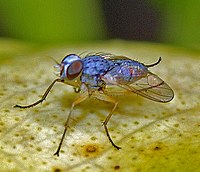
Host plant influences establishment and performance of Amblydromalus limonicus, a predator for Bactericera cockerelli.
Sign Up to like & getrecommendations! Published in 2019 at "Pest management science"
DOI: 10.1002/ps.5179
Abstract: BACKGROUND Management of tomato potato psyllid (TPP; Bactericera cockerelli (Šulc)) predominantly relies on insecticides. However, biological control agents (BCAs) could provide viable alternatives to suppress TPP populations. In this laboratory experiment, we assessed the predatory… read more here.
Keywords: amblydromalus limonicus; tomato; bactericera cockerelli; limonicus ... See more keywords

A new picorna-like virus identified in populations of the potato psyllid Bactericera cockerelli.
Sign Up to like & getrecommendations! Published in 2021 at "Archives of virology"
DOI: 10.1007/s00705-021-05281-x
Abstract: The potato/tomato psyllid Bactericera cockerelli (Hemiptera: Triozidae) is a pest of Solanaceae plants and a vector of the pathogenic bacterium 'Candidatus Liberibacter solanacearum', which is associated with zebra chip disease in potato. This disease is… read more here.
Keywords: picorna like; psyllid bactericera; like virus; bactericera cockerelli ... See more keywords

Evaluating combined use of a parasitoid and a zoophytophagous bug for biological control of the potato psyllid, Bactericera cockerelli
Sign Up to like & getrecommendations! Published in 2017 at "Biological Control"
DOI: 10.1016/j.biocontrol.2016.12.003
Abstract: Abstract Bactericera cockerelli (Sulc) is an important pest of solanaceous crops and a vector of the pathogen Candidatus Liberibacter solanacearum . Biological control of this pest has been attempted using either the parasitoid, Tamarixia triozae… read more here.
Keywords: bactericera cockerelli; cockerelli; biological control; choice ... See more keywords

Ecology and management of Bactericera cockerelli and Candidatus Liberibacter solanacearum in New Zealand
Sign Up to like & getrecommendations! Published in 2020 at "Journal of Integrative Agriculture"
DOI: 10.1016/s2095-3119(19)62641-9
Abstract: Abstract The psyllid Bactericera cockerelli was first reported in New Zealand in 2006 and spread quickly throughout all potato growing regions. In 2009, B. cockerelli was associated with the plant pathogenic bacterium Candidatus Liberibacter solanacearum,… read more here.
Keywords: new zealand; bactericera cockerelli; cockerelli; management ... See more keywords

Acquisition and transmission of "Candidatus Liberibacter solanacearum" differs among Wolbachia-infected and -uninfected haplotypes of Bactericera cockerelli.
Sign Up to like & getrecommendations! Published in 2023 at "Plant disease"
DOI: 10.1094/pdis-11-22-2701-re
Abstract: "Candidatus Liberibacter solanacearum" (Lso) causes disease symptoms and economic losses in potato, tomato, and other solanaceous crops in North America. Lso is transmitted to plants by potato psyllid, Bactericera cockerelli, which occurs as distinct haplotypes… read more here.
Keywords: infection; liberibacter solanacearum; candidatus liberibacter; lso ... See more keywords

Chromosomal‐level assembly of Bactericera cockerelli reveals rampant gene family expansions impacting genome structure, function and insect‐microbe‐plant‐interactions
Sign Up to like & getrecommendations! Published in 2022 at "Molecular Ecology Resources"
DOI: 10.1111/1755-0998.13693
Abstract: Lineage specific expansions and gene duplications are some of the most important sources of evolutionary novelty in eukaryotes. Although not as prevalent in eukaryotes compared to bacteria, horizontal gene transfer events can also result in… read more here.
Keywords: insect microbe; genome; bactericera cockerelli; gene ... See more keywords

Prototype 3D-Printed Traps Capture Bactericera cockerelli (Šulc) (Hemiptera: Triozidae) Directly into Preservative for Improved Detection of “Candidatus Liberibacter solanacearum”
Sign Up to like & getrecommendations! Published in 2020 at "Journal of Entomological Science"
DOI: 10.18474/0749-8004-55.2.147
Abstract: Abstract Potato psyllid, Bactericera cockerelli (Šulc) (Hemiptera: Triozidae), is a key pest of potato (Solanum tuberosum L.) and other solanaceous crops (Solanales: Solanaceae) as a vector of “Candidatus Liberibacter solanacearum” (Lso), the pathogen associated with… read more here.
Keywords: ulc hemiptera; detection; bactericera cockerelli; cockerelli ulc ... See more keywords

Chili Pepper Jojutla Morelos (Capsicum annuum L.), CJ-2018: A Variety Resistant to Bactericera cockerelli
Sign Up to like & getrecommendations! Published in 2022 at "Insects"
DOI: 10.3390/insects13080742
Abstract: Simple Summary Bactericera cockerelli is a pest in different crops including chili, one of the main vegetables worldwide. The presence of this pest in crops causes significant damage to their yield. The control of B.… read more here.
Keywords: bactericera cockerelli; cockerelli; control; chili pepper ... See more keywords

Treatment of Rapamycin and Evaluation of an Autophagic Response in the Gut of Bactericera cockerelli (Sulč)
Sign Up to like & getrecommendations! Published in 2023 at "Insects"
DOI: 10.3390/insects14020142
Abstract: Simple Summary In North America, the Gram-negative plant bacterial pathogen ‘Candidatus Liberibacter solanacearum’ (Lso) imposes a serious threat to most solanaceous crops, and in potato, it causes zebra chip disease. Lso is transmitted by the… read more here.
Keywords: bactericera cockerelli; response; microscopy; potato psyllid ... See more keywords